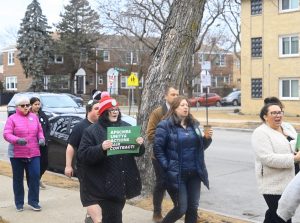NEIU and Other Universities Across Chicago Lack Faculty Diversity
March 28, 2019
NEIU is considered the most diverse public university in the midwest and the website claims the diversity “affects the core of the institution – we learn, teach, and work in an environment that is made richer, more relevant and more rewarding by the deeply diverse group of individuals that makes up our University community.”
However, according to the university’s instructional faculty by academic rank, out of a total of 597 faculty members, 368 (61.6 percent) are white individuals.
But NEIU isn’t the only Chicago university to lack faculty diversity. In 2017, University of Illinois at Chicago reported 43 percent white faculty members.
In the same year, Columbia College Chicago reported 79 percent white full-time instructional staff and 80 percent white part-time instructional staff, coming in at an average of 79.5 percent white faculty.
Loyola University’s most recent faculty demographics report is also from 2017, it states their faculty breakdown was: 82.4 percent white; 0 percent Native American; 6.3 percent Asian; 5.9 percent African American; 4.4 percent Hispanic; 0.2 percent Native Hawaiian/Pacific Islander; and 0.9 percent two or more races.
DePaul University’s most recent faculty demographic analysis is from 2014-15 and alluded to a white faculty percentage of 80.4 percent. On their website it states: “Among the 919 full-time faculty members for the 2014-2015 academic year, 67 were African-Americans, 50 were Hispanic/Latino, 51 were Asian-Americans, 8 were multiracial and 3 were Native Americans – together representing 19.4 percent.”
NEIU student Carlos Gutierrez said, “I don’t find the lack of diversity in our faculty to be too distracting, it doesn’t really take me out of my studies. Most of the professors I have had as of now have made a positive impact on me, not necessarily because of race but because their teaching style works for my style of learning.”
According to an article from The New York Times, diversity amongst faculty has a bigger impact on male students. According to the article, the studies showed that educator diversity can impact a male, particularly black male, student’s performance and interest in school more than female students.
The New York Times stated: “When black children had a black teacher between third and fifth grades, boys were significantly less likely to later dropout of high school, and both boys and girls were more likely to attend college, Mr. Gershenson and his colleagues found in a large study last year. The effect was strongest for children from low-income families. The study included 106,000 students who entered third grade in North Carolina from 2001 to 2005, and it followed them through high school. There was no effect on white children when they had a black teacher.”
Gutierrez said that as a Hispanic male pursuing a career in education, “bringing in diversity does give me more motivation to become a teacher.”
What can be done to increase this number? Forbes suggests that asking faculty input on new hires may be a way to increase and foster diversity in the workplace along with keeping an open line of communication between administration and faculty.
Statistics and responses from Roosevelt University, North Park University and Illinois Institute of Technology were not available at time of print.






